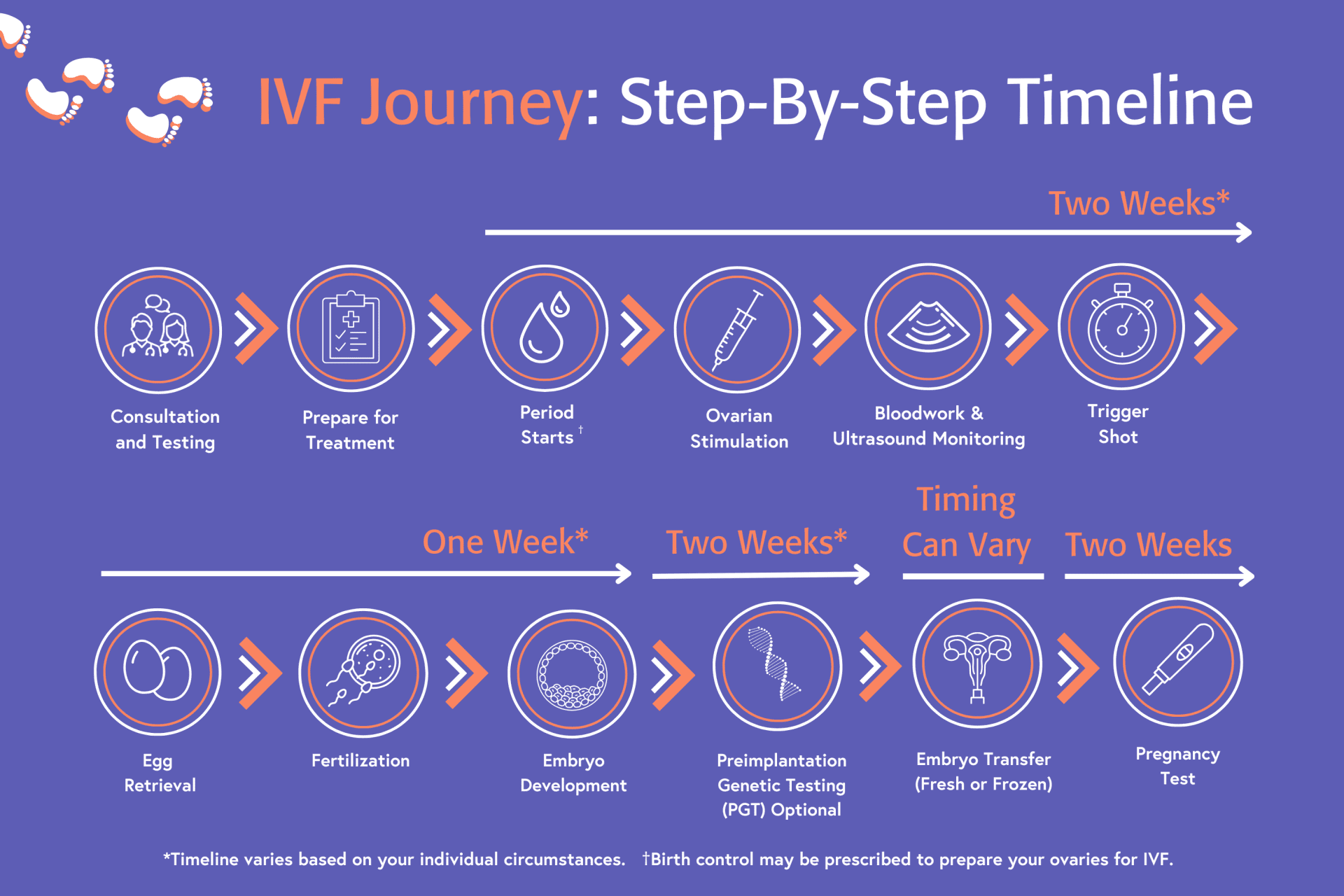In Vitro Fertilization (IVF)
In vitro fertilization (IVF) is a type of assisted reproductive technology (ART) where eggs are fertilized by sperm outside the body, in a laboratory, and then transferred into the uterus.
What is In Vitro Fertilization (IVF)?
In vitro fertilization (IVF) is a procedure in which a reproductive endocrinologist fertilizes one or more eggs with sperm inside the embryology laboratory. The most viable embryos are then transferred into the uterus. IVF is the most successful treatment you can do using your own eggs and sperm (or those of a donor). Fertility Centers of Illinois uses the most innovative and advanced technologies which are the key to our high success rates.
IVF Step-By-Step Timeline
A standard IVF cycle usually takes about 5–8 weeks, starting from the first day of your period and ending with your pregnancy test. Because every journey is unique, your timeline may differ based on your individual needs. The IVF process includes ovarian stimulation and monitoring, egg retrieval, semen preparation, fertilization, optional PGT testing, and embryo transfer.
The IVF Process
Your journey begins with a conversation with your physician to explore your goals, vision, and dreams of building a family. Together, you’ll create a personalized action plan tailored to give you the best chance of success. Miracles don’t happen overnight, but we’re here to support your pace — whether you’re eager to move quickly or prefer to take things slow.
- Consultation and Fertility Testing: Consultation and Fertility Testing: Discuss your goals with your physician who will order fertility testing to identify any underlying causes of infertility and determine your personalized treatment plan.
- Prepare for Treatment: Ensure your pre-treatment checklist is completed. This includes signing all consents, gaining medical and financial clearance, confirming your pharmacy, ordering and receiving medications, and reviewing your calendar for medications. You may be prescribed medications, including birth control, to prepare your ovaries prior to beginning IVF treatment.
- Period Starts: Day 1 of IVF treatment starts on the first day of your menstrual cycle. Once your period begins, notify the nurses.
- Ovarian Stimulation: Your care team will let you know when to begin your daily medications, which are designed to stimulate your ovaries to produce and develop multiple follicles. Follicles contain eggs, so the ovaries are stimulated to produce as many healthy follicles as possible.
- Bloodwork and Ultrasound Monitoring: You will return to the clinic to assess your response to medications and avoid under or over-stimulation. Ultrasound measures follicle size to make sure they are growing. Bloodwork measures hormone levels and medications are adjusted accordingly.
- Trigger Shot: A hormone injection that triggers the final maturation of eggs will be administered around days 9-12 to get your eggs ready for collection. This shot is time-sensitive. Your care team will give you a specific time of day that the shot needs to be administered. Your egg retrieval will occur 36 hours later.
- Egg Retrieval: Around days 13-14, you will have an egg retrieval procedure. General anesthesia will be administered during the retrieval to ensure comfort. Following the procedure, your care team will inform you of how many eggs were collected.
- Fertilization: The eggs collected will be fertilized with a semen sample on the same day as the egg retrieval.
- Embryo Development: The fertilized eggs will develop in an incubator for 5-6 days after fertilization where their cells will hopefully divide and develop into blastocysts, signifying they are maturing to evolve into a healthy embryo.
- Preimplantation Genetic Testing (PGT) (Optional): PGT to screen for genetic and chromosomal abnormalities is optional once your embryo reaches the blastocyst stage. PGT will require a frozen embryo transfer (FET). PGT results take up to 2 weeks to receive.
- Embryo Transfer (Fresh or Frozen): The highest quality embryos are viable for transfer and transferred into the uterus during a quick procedure that requires no anesthesia. The timing of your transfer will be based on your specific circumstances and menstrual cycle.
- Pregnancy Test: A blood test will reveal your pregnancy results within 2 weeks following your embryo transfer. If your test is positive, we will schedule an ultrasound approximately 3 weeks later.
*Timeline varies based on your individual circumstances. Birth control may be prescribed to prepare your ovaries for IVF.

Download the IVF Timeline
Check out our downloadable IVF timeline. We understand this is a lot to take in, so you can easily view, save, or print the PDF version for your convenience.
View PDF TimelineEmpower your future in three easy steps

Schedule an appointment

Discuss your

Some fertility
How to get started
Fertility Centers of Illinois has treatment options to help almost everyone build the family of their dreams. It all starts with a doctor consultation.
When to Seek IVF Treatment
Once diagnostic testing is complete, your physician will review your treatment options. Many patients start with basic, ‘low-tech’ treatments like hormone therapies or IUI and then transition to IVF if needed. While IVF is not always the first step in treatment, it is a highly effective approach that fertility specialists use when less aggressive options are not successful.
There are instances when IVF would be the first line of treatment. IVF is recommended for patients with the following conditions:
Advanced maternal age: Age is the single biggest factor affecting the chances of conceiving and having a healthy baby because egg quantity and quality decline with age. By age 40, the chance of getting pregnant on your own each month is approximately 1%.
Tubal disease or tubal ligation: If a patient has a tubal ligation, IVF treatment would be the best treatment option since it bypasses the Fallopian tubes to achieve pregnancy.
Severe male factor infertility: If the semen analysis shows there are not enough healthy sperm to be successful with more basic treatment, such as intrauterine insemination (IUI), then IVF treatment can help patients overcome male factor infertility. With IVF treatment, an advanced method of fertilization known as intracytoplasmic sperm injection (ICSI) (pronounced “ick-see”) can be performed in the lab. With ICSI, only one healthy sperm is needed for each egg.
Severe Endometriosis: For women who have this condition, their endometrial tissue (the tissue lining the inside of the uterus) grows outside of the uterus. The endometrial tissue can attach to other organs in the abdominal cavity, such as the ovaries and the Fallopian tubes. The uterus will respond to this tissue the same way it responds to menstrual cycle hormones – it will swell and thicken and ultimately, shed.
Recurrent miscarriage: Recurrent miscarriage, also called recurrent pregnancy loss, is defined as two or more consecutive clinical pregnancy losses before 20 weeks gestation. It is important to consider clinical pregnancies rather than biochemical pregnancies, as biochemical pregnancies are usually not included in a diagnosis of recurrent pregnancy loss.
Poor ovarian reserve: Diminished ovarian reserve, also referred to as low ovarian reserve or low egg count, is when there are fewer eggs in the ovaries compared to people of the same age. If there is a low ovarian reserve, the chance of getting pregnant decreases while the chance of miscarriage increases.
FAQ
Resources
Patient Stories
Patient Story
Rachel and Mike
Patient Story
Stephanie’s Story
Patient Story
A Journey to Parenthood: Overcoming PCOS with Hope …
Patient Story







